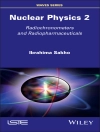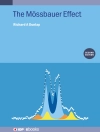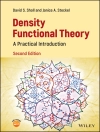Einführung in die Festkörperphysik für Studenten der Werkstofftechnik, Materialwissenschaften und verwandter technischer Fachrichtungen. Dieses zugängliche Lehrbuch ist ausreichend detailliert, ohne dabei zu theorielastig zu sein, und stellt die Verbindung zu heutigen Technologien her.
Tabla de materias
Contents
Preface xi
Introduction xiii
1 General Impact of Translational Symmetry in Crystals on Solid State Physics 1
1.1 Crystal Symmetry in Real Space 3
1.2 Symmetry and Physical Properties in Crystals 9
1.3 Wave Propagation in Periodic Media and Construction of Reciprocal Lattice 13
1.A Symmetry Constraints on Rotation Axes 18
1.B Twinning in Crystals 20
2 Electron Waves in Crystals 23
2.1 Electron Behavior in a Periodic Potential and Energy Gap Formation 23
2.2 The Brillouin Zone 28
2.3 Band Structure 31
2.4 Graphene 35
2.5 Fermi Surface 40
2.A Cyclotron Resonance and Related Phenomena 43
3 Elastic Wave Propagation in Periodic Media, Phonons, and Thermal Properties of Crystals 51
3.1 Linear Chain of the Periodically Positioned Atoms 51
3.2 Phonons and Heat Capacity 56
3.3 Thermal Vibrations of Atoms in Crystals 59
3.4 Crystal Melting 60
3.5 X-ray and Neutron Interaction with Phonons 61
3.5.1 Debye-Waller Factor 65
3.6 Lattice Anharmonicity 67
3.7 Velocities of Bulk Acoustic Waves 69
3.8 Surface Acoustic Waves 72
3.A Bose’s Derivation of the Planck Distribution Function 73
4 Electrical Conductivity in Metals 75
4.1 Classical Drude Theory 76
4.2 Quantum-Mechanical Approach 77
4.3 Phonon Contribution to Electrical Resistivity 80
4.4 Defects’ Contributions to Metal Resistivity 82
4.A Derivation of the Fermi-Dirac Distribution Function 84
5 Electron Contribution to Thermal Properties of Crystals 87
5.1 Electronic Specific Heat 87
5.2 Electronic Heat Conductivity and the Wiedemann-Franz Law 92
5.3 Thermoelectric Phenomena 94
5.4 Thermoelectric Materials 98
6 Electrical Conductivity in Semiconductors 105
6.1 Intrinsic (Undoped) Semiconductors 105
6.2 Extrinsic (Doped) Semiconductors 110
6.3 p-n Junction 111
6.4 Semiconductor Transistors 117
6.A Estimation of Exciton?s Radius and Binding Energy 120
7 Work Function and Related Phenomena 123
7.1 Work Function of Metals 123
7.2 Photoelectric Effect 126
7.2.1 Angle-Resolved Photoemission Spectroscopy (APRES) 126
7.3 Thermionic Emission 128
7.4 Metal-Semiconductor Junction 131
7.A Image Charge Method 133
7.B A Free Electron Cannot Absorb a Photon 134
8 Light Interaction with Metals and Dielectrics 135
8.1 Skin Effect in Metals 137
8.2 Light Reflection from a Metal 138
8.3 Plasma Frequency 140
8.4 Introduction to Metamaterials 141
8.5 Structural Colors 148
8.A Acoustic Metamaterials 150
9 Light Interaction with Semiconductors 155
9.1 Solar Cells 155
9.1.1 The Grätzel Cell 159
9.1.2 Halide Perovskite Solar Cells 161
9.2 Solid State Radiation Detectors 162
9.2.1 Infrared Detectors 164
9.3 Charge-Coupled Devices (CCDs) 167
9.4 Light-Emitting Diodes (LEDs) 168
9.5 Semiconductor Lasers 170
9.6 Photonic Materials 173
10 Cooperative Phenomena in Electron Systems: Superconductivity 177
10.1 Phonon-Mediated Cooper Pairing Mechanism 178
10.2 Direct Measurements of the Superconductor Energy Gap 182
10.3 Josephson Effect 184
10.4 Meissner Effect 185
10.5 SQUID 188
10.6 High-Temperature Superconductivity 189
10.A Fourier Transform of the Coulomb Potential 192
10.B The Josephson Effect Theory 193
10.C Derivation of the Critical Magnetic Field in Type I Superconductors 195
11 Cooperative Phenomena in Electron Systems: Ferromagnetism 197
11.1 Paramagnetism and Ferromagnetism 198
11.2 The Ising Model 204
11.3 Magnetic Structures 205
11.4 Magnetic Domains 207
11.5 Magnetic Materials 210
11.6 Giant Magnetoresistance 211
11.A The Elementary Magnetic Moment of an Electron Produced by its Orbital Movement 214
11.B Pauli Paramagnetism 214
11.C Magnetic Domain Walls 216
12 Ferroelectricity as a Cooperative Phenomenon 219
12.1 The Theory of Ferroelectric Phase Transition 223
12.2 Ferroelectric Domains 227
12.3 The Piezoelectric Effect and Its Application in Ferroelectric Devices 230
12.4 Other Application Fields of Ferroelectrics 233
13 Other Examples of Cooperative Phenomena in Electron Systems 237
13.1 The Mott Metal-Insulator Transition 237
13.2 Classical and Quantum Hall Effects 241
13.3 Topological Insulat
Sobre el autor
Emil Zolotoyabko is Professor Emeritus in the Department of Materials Science and Engineering at the Technion – Israel Institute of Technology. He was awarded the 2001 Henry Taub Prize for Academic Excellence and held the Abraham Tulin Academic Chair. Emil Zolotoyabko has authored more than 200 scientific publications, four books, and four chapters in books devoted to the development of new X-ray diffraction methods and their applications for studying the structure and dynamical characteristics of different materials systems.












